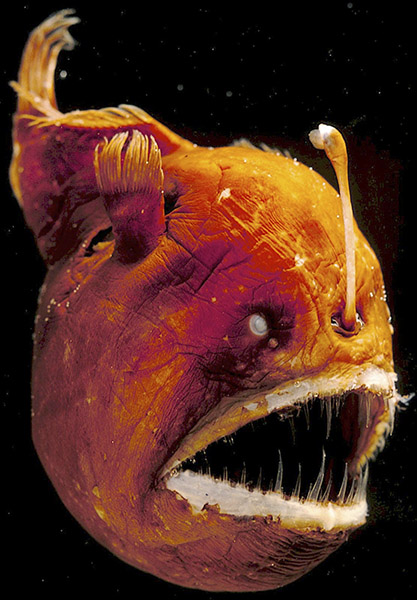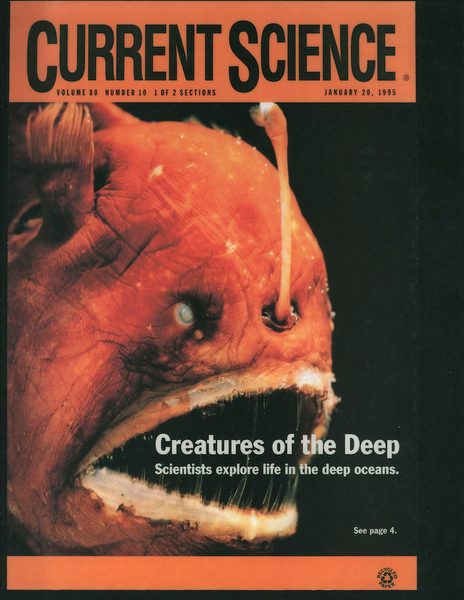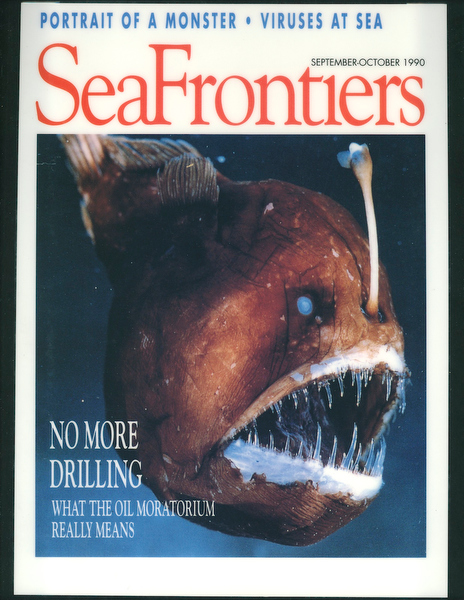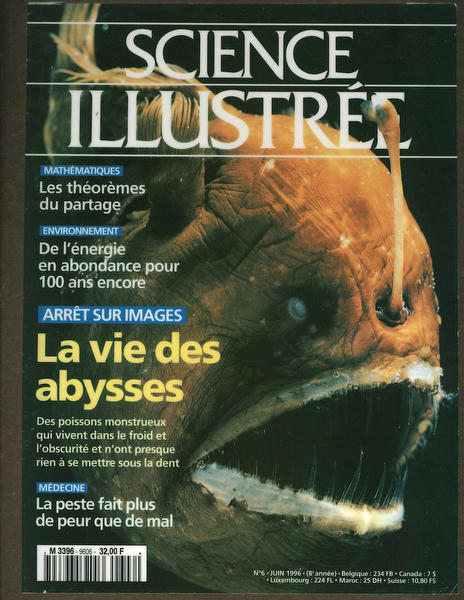Norbert Wu’s Favorite Images: Deep Sea Anglerfish

After my San Blas experience, I took courses in marine biology and eventually spent two years as a doctoral student at Scripps Institution of Oceanography. Photography took up more and more of my time. I convinced my friend Spencer Yeh to spend two months with me, diving every day in the cold but astoundingly rich waters of Monterey Bay. I took my first course in ichthyology and was fortunate enough to be exposed to the encyclopedic knowledge of Dr. Richard Rosenblatt, the curator of the Marine Vertebrate Collection at Scripps. His course was filled with the details and observations of natural history that I had been looking for my whole life.
Here is one of my favorite - and very widely published - images from that period of my life. The image shows a deep-sea anglerfish along with its bioluminescent fishing lure. It was published on the cover of TIME magazine in 1995, which was a big deal at the time. I’ve included an essay that I wrote about this and other images of deep-sea fishes below. This particular image was published on dozens of magazine covers over the years, some of which I’ve included below also.

You learn to be patient on a boat that is trawling in the deep sea. A huge net, as wide as the side of a barn, is lowered overboard from a 200-foot long steel-hulled research vessel. The vessel may cost as much as $10,000 or more per day for the scientist whose grant is supporting the expedition. It may take days to lower the net to the depth being studied, to collect enough material, and to raise the net. After all of this work and after sifting out miles and miles of water, the contents of this huge net may yield only a few globs of protoplasm. Jellyfish and soft-bodied animals are destroyed, as are most of the fish. If you are lucky, perhaps a single deep-sea fish is still in good shape. Only in extremely rare instances does something like an anglerfish couple come to light.

These fishes were netted on a series of research expeditions. The photographs were taken as the fishes were brought up, in a shipboard tank, or later when they were preserved for the Marine Vertebrate Collection at Scripps Institution of Oceanography. Very few fish were alive when photographed, and none were photographed in their natural habitat. It is the temperature difference more than anything else that kills deep-sea fish as they are brought to the surface. Although deep-sea fish experience an enormous change in pressure as they are brought to the surface, most don’t possess a swim bladder. The expansion of the swim bladder, due to change in pressure, is the usual cause of death in fish brought up from shallower depths. Most deep-sea fishes are surprisingly small, ranging in size from two inches to three feet. Their bodies are light and oily, and their bones and teeth are brittle and flexible, the better to hover motionless in the water.

The bizarre and grotesque form of deep-sea fish were once thought to be extremely primitive. However, the photographs of the cleared and stained specimens graphically illustrate the fact that these fish are highly advanced animals that evolved in upper surface waters and were forced out of their original habitat by competition from other species millions of years ago. As they adapted to life in the deep ocean, these creatures evolved the many features characteristic of deep-sea fishes – light organs; oily, soft bodies; tubular eyes; needle-sharp teeth; and huge mouths and stomachs.

The Deep-Sea Anglerfish
Creep from the Deep
Life in the upper 300 feet of the ocean is blessed with life- giving sunlight. This rich, familiar top layer of our oceans is a thin cover to an enormously deep basin averaging two and a half miles in depth. The other 98.5 percent of the oceans has only recently fallen underneath man’s gaze, through new robot and submersible technologies, and literally earth-shaking discoveries have been made through the exploration of the ocean depths. The region of the deep ocean is the largest living space on earth, and its inhabitants have only recently been observed and described to science. One of the more frightening-looking inhabitants is this six-inch long ceratioid anglerfish, Melanocetus johnsoni, which was trawled up from a depth of 3000 meters on a Scripps Institution of Oceanography cruise. Perhaps the most frightening aspect of this fish is the fact that it is female, and twenty times the size of a male!
The Environment : Blackness, Cold, and High Pressures
At 300 feet down, the deepest scuba divers can go, there is barely enough sunlight for a plant to photosynthesize, or produce tissue from the energy of light. At 3000 feet, sunlight has disappeared completely, and fishes swim in utter darkness. At such great, dark depths, the water temperatures are generally a constant, low 4 degrees Centigrade. Life in the deep sea has evolved numerous adaptations to deal with the darkness, lack of food, and high pressures of the abyss.
Food is scarce down there, and so fishes have developed many ways to make themselves neutrally buoyant, wasting little energy on trying to keep afloat. The skeletons and vicious-looking teeth are flimsy, muscles are weakly developed, and eyes, brains, gills, and kidneys are often very small. Neutrally buoyant, they are able to hover in the sea without undue effort, luring their prey rather than chasing it.
Living Light
In the pitch darkness of water 1000 meters deep, fishes with elaborate light sources are abundant, and the pattern, designs, and probable functions of these light sources are a lesson in evolution. These light sources may attract prey, signal mates, render the sender invisible, confound predators, and even serve as invisible light beams. The pattern of light organs for a given fish distinguishes the species and may be used as recognition signs.
The fish down in these depths don’t get to eat very often, so they take full advantage of every chance they get. Should a fish encounter a potential meal, it will likely eat it, regardless of the prey’s size. Many fishes have developed huge fangs, hinged mouths, and tremendously extensible stomachs to accommodate large prey. Deep-sea anglerfish use “fishing poles,” extensions of their dorsal fin, with luminous lures that are wriggled about to attract other fish. If the winking lure attracts a gullible fish, squid, or prawn, the lure and prey can be drawn towards the large and powerful jaws, which bear long pointed teeth. Large female ceratioids have been recorded taking prey two or three times their own length. They may even have teeth in the back of their throats to keep prey from escaping as they are being swallowed.
Honey, I’m Home
Encountering a mate of your own species in these dark depths can be difficult indeed, and the question of how two compatible mates meet in the vastness of the deep ocean remains one of science’s big mysteries. Ceratioid anglerfishes are extremely rare. Scientists report catching an average of only one such anglerfish in two weeks of trawling. The anglerfish has developed a strategy to guarantee that any meeting between sexes is fruitful. When a male encounters a female of the same species, he will attach himself to her with his mouth, riding along. Gradually the male becomes a parasite of the female; his mouth fuses to her body, and blood vessels actually form between the couple. The male degenerates into nothing but gonads and a surrounding lump of tissue - a permanent, portable sperm supply, about one-twentieth the size of the female
Dwarf males solve many problems, not the least of which is being there for the woman all the time, every time, all night, every night. Not only is the energy budget of the population reduced, but there is less competition for food between the sexes. Scientists term him “an obligatory sexual parasite,” and a “dwarf male parasite.”

About the author:
Norbert Wu is an independent photographer and filmmaker who specializes in marine issues. His writing and photography have appeared in thousands of books, films, and magazines. He is the author and photographer of seventeen books on wildlife and photography and the originator and photographer for several children’s book series on the oceans. Exhibits of his work have been shown at the American Museum of Natural History, the California Academy of Sciences, the National Academy of Sciences, and the National Museum of Wildlife Art.
He was awarded National Science Foundation (NSF) Artists and Writers Grants to document wildlife and research in Antarctica in 1997, 1999, and 2000. In 2000, he was awarded the Antarctica Service Medal of the United States of America “for his contributions to exploration and science in the U.S. Antarctic Program.” His films include a pioneering high-definition television (HDTV) program on Antarctic’s underwater world for Thirteen/WNET New York’s Nature series that airs on PBS.
He is one of only two photographers to have been awarded a Pew Marine Conservation Fellowship, the world’s most prestigious award in ocean conservation and outreach. He was named “Outstanding Photographer of the Year” for 2004 by the North American Nature Photographers Association (NANPA), the highest honor an American nature photographer can be given by his peers.